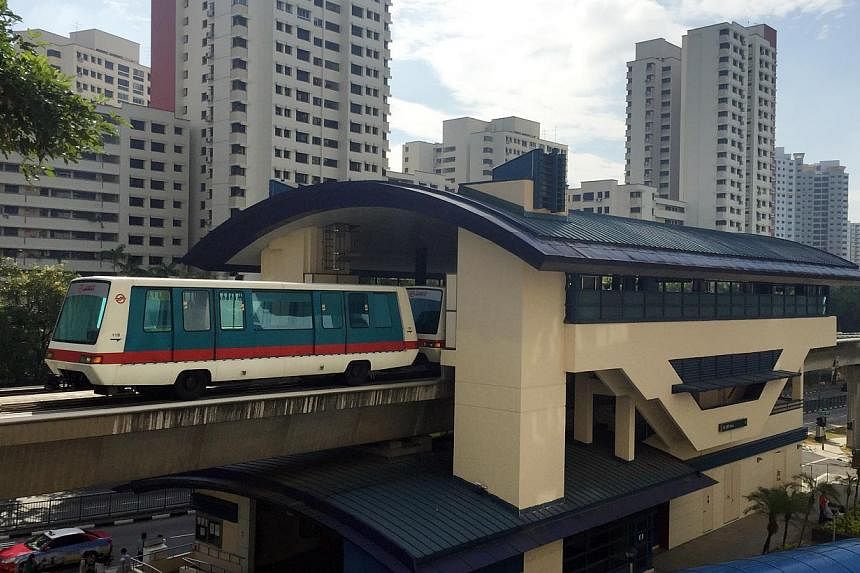SINGAPORE - A blaze that started in the electrical room at Senja station along the Bukit Panjang Light Rail Transit (LRT) line damaged circuit breakers and shut down service on Monday evening.
Services were closed through the peak periods on Monday evening and Tuesday morning. The incident has put the spotlight on the Mass Rapid Transit's (MRT) less-travelled cousin. Here are six facts about the LRT system.
1. The first LRT line was started in 1999

The Bukit Panjang LRT line was the first of its kind in Singapore. It was launched in 1999 to make Bukit Panjang residents more connected. The system was estimated to cost $285 million.
2. There are currently three LRT lines, all are driverless
The Bukit Panjang LRT line is operated by SMRT, while the ones in Punggol and Sengkang are operated by SBS Transit.
The Bukit Panjang LRT network loops and stops at 14 stations. Bukit Panjang LRT station is set to be a Downtown Line interchange in the first quarter of 2016.
The Sengkang LRT has 14 stations while the Punggol LRT has 15. Both the LRT systems consist of East and West loops. They provide Sengkang and Punggol residents a transfer to the North-East MRT Line.
All LRT trains are driverless and fully automated.
3. A collision on the LRT line led to the first-ever fine for a train operator
According to media reports in December 2000, operator Singapore Light Rapid Transit, a wholly-owned subsidiary of SMRT then, was fined $10,000 for the collision of two LRT trains at Phoenix Station along the Bukit Panjang line. Five people were hurt. The fine was imposed by the Land Transport Authority (LTA) and was the first to be meted out to any train operator at the time. The subsidiary is now called SMRT Light Rail.
The accident was caused by an employee who had dismissed an alarm that had warned of a "lost" train. One LRT train had crashed into another stationary one after he reset the system. It stirred fears that the first unmanned train line was not safe.
4. The Bukit Panjang LRT line has been running in the red since it started
According to a Straits Times article in 2003, operator SMRT lost up to $3 million a year from the time the Bukit Panjang LRT line was launched in 1999, despite cost-saving measures.
Between 1999 and 2003, the service broke down about 50 times. One breakdown even lasted for five days. The system suffered from power failure, problems with the trains' brakes and problems with the train system's design and maintenance, including poor supervision. By 2012, it had suffered about 150 breakdowns. Commuters who use the line currently complain that service is inconsistent and that trains are overcrowded.
In the most recent quarter that ended in December 2014, the Bukit Panjang LRT continued to bleed.
5. Sengkang and Punggol LRT lines

The Sengkang LRT line was announced in 1996, and the $302-million line started service at six stations in January 2003. Eight of its 14 stations in the less populated west loop then were not opened till January 2005.
The Punggol LRT started rolling in January 2005, with trains plying only the eastern loop and stopping at five out of seven stations deemed to have enough commuter traffic. The Punggol line cost $354 million to build.
6. LTA announced upgrades for all three LRT lines in 2012
LTA announced in 2012 that the Sengkang and Punggol LRT train capacity will increase by the year 2016 to meet future demand. It said it will modify 16 of the 41 existing single train-cars to allow two-car operations. It also said it will increase the the train fleet on these two lines by about 40 per cent, by procuring 16 more train cars. LTA also said that for the Sengkang and Punggol lines, modifications will be made to the power, signalling and communication sub-systems to enhance overall system capacity. In the same announcement, LTA revealed the addition of 13 train cars for the Bukit Panjang LRT line. Two of the trains started service in November 2014.
Sources: The Straits Times, Land Transport Authority, SMRT, SBS Transit

